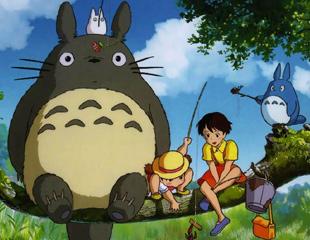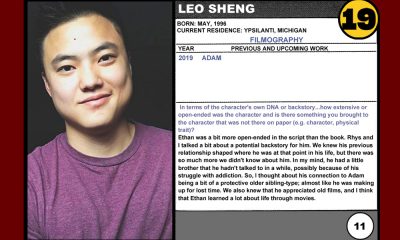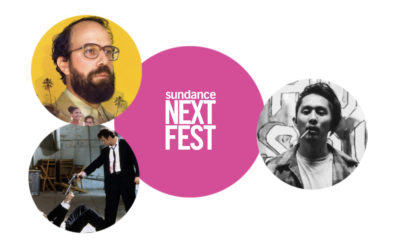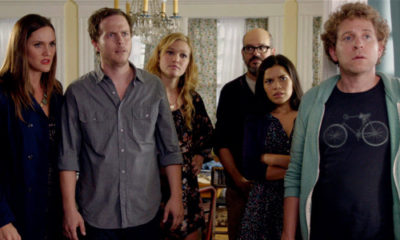Retro IONCINEMA.com
Studio Ghibli Retrospective at the TIFF Lightbox
Anyone who loves classic hand drawn animation surely is familiar with the Japanese giant, Studio Ghibli, and the fat and fluffy Totoro creature that accompanies the title. Hell, at the very least, most Americans have been introduced to Totoro from his cameo appearance in the latest iteration of Toy Story.
Anyone who loves classic hand drawn animation surely is familiar with the Japanese giant, Studio Ghibli, and the fat and fluffy Totoro creature that accompanies the title. Hell, at the very least, most Americans have been introduced to Totoro from his cameo appearance in the latest iteration of Toy Story. Since the mid 80s, the Japanese animation studio has been pumping out world renowned classics that have managed to bundle humane wonder with traditional Japanese culture while presenting them with universal appeal to both adults and children alike. With the genius of writers/directors Hayao Miyazaki and Isao Takahata behind the original stories, and an instantly recognizable style that skews the traditional Japanese anime look, Studio Ghibli has cemented itself as the leader in keeping the intimate art of hand drawn animation alive.
Twenty-seven years after the success of Miyazaki’s Nausicaä of the Valley of the Wind and the subsequent foundation of Studio Ghibli, Toronto’s TIFF Bell Lightbox is hosting a month long retrospective featuring fifteen of the studio’s films. Beginning on tomorrow, March 10th, the film series, dubbed Spirited Away: The Films of Studio Ghibli, will screen the films of Miyazaki and Takahata, as well as other Ghibli productions directed by the likes of Tomomi Mochizuki, Hiroyuki Morita, and Yoshifumi Kondo, all through newly struck 35mm prints. Many of the selections are screening multiple times over the course of the month, some of which have screenings in both the original Japanese language track, and the American star studded English language dubbed tracks.
Suitably starting at the origins of Ghibli’s history, the retrospective kicks off with Nausicaä of the Valley of the Wind and is trailed by a screening of its successful follow-up, Castle In The Sky. Both films set the standard for the studio’s signature look, as well as introduce the philosophic theme base that the Ghibli catalog is built upon. From there, the schedule branches out among Ghibli releases every which way.
Miyazaki’s biggest worldwide hits are no-brainer inclusions among the numerous screening selections. The kid friendly Kiki’s Delivery Service and the ecologically impassioned Princess Mononoke were the first films to really find a US audience thanks to Disney’s distribution of the films in 1998 and 1999. The auteur’s monumental masterwork, Spirited Away, tells the eye popping story of a girl who tries to save her parents from a gluttonous life entrapped in the spirit world, and it was the first anime film to win an Academy award. Strangely, the follow up, Howl’s Moving Castle, which was also nominated for an Oscar, is only receiving one lone screening in comparison to its award winning counterparts which are scheduled for multiple showings each.
Also included in the retrospective is Porco Rosso, an oddball creation within Miyazaki’s filmography that features the tale of a retired Italian World War I pilot who has been cursed to look like a pig for the remainder of his life. This is the lone film that marks a departure from Japanese cultural foundations while setting the story within a set political context (that of post-WWI depression and the rise of Italian fascism). Among the remaining Miyazaki features are the fan favorite My Neighbor Totoro, and his latest directorial effort, Ponyo.
Along with the entirety of Miyazaki’s fantastical Ghibli output and a few selections by Takahata such as the Japanese raccoon legend based Pom Poko and the wholly computer animated My Neighbors the Yamadas, rarely seen films like Mochizuki’s The Ocean Waves, Sumaseba’s Whisper of the Heart, and its spiritual successor, Morita’s The Cat Returns are also screening a handful of times over the course of the retrospective. Strangely, Takahata’s historically-based, somber masterpiece, Grave of the Fireflies, was not included in the series.
Being that North Americans missed the boat for the majority of Studio Ghibli’s undeniably influential catalog, this may be one of the few chances to take in these animated gems on the silver screen in all their glory. Witness the lush environments, the fluid animation, and their seamless integration of culturally relevant stories and majestic wonder as they were meant to be seen. Bring your kids. Bring your parents. Bring everyone you know. Everyone should experience at least the renowned titles included in the series. And for the growing population of Ghibli fanatics, now is your chance to check out the lesser known titles in one of the nicest theaters in North America, the TIFF Bell Lightbox.



























